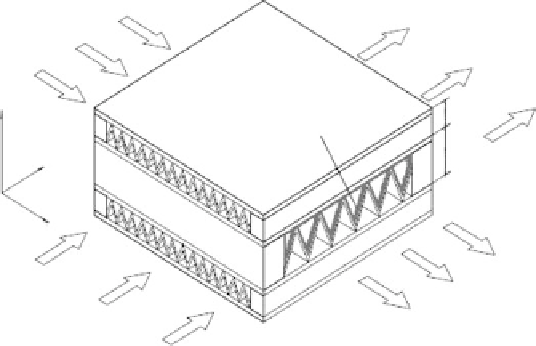Environmental Engineering Reference
In-Depth Information
Z
£
£
Y
X
Figure 16.3.5
Desiccant coated cross-cooled compact dehumidifier (Yuan et al., 2008).
This means that the temperature of the air after passing the desiccant material is not
increased. Hence, the sorption process is increased due to the removal of sorption
heat. Yuan et al. (2008) proposed a cross-cooled compact solid desiccant dehumid-
ifier. The aim of this design is to make the dehumidification process cooler due to
the heat exchange between the dehumidified air and the secondary air. The perfor-
mance of the design was shown to be better without secondary cooling. Majumdar
and Worek (1989) investigated the open-cycle cooled-bed desiccant air-conditioning
system using a cooled-bed dehumidifier. Here, system performance is more sensitive
to regeneration and indoor temperature and to the outdoor humidity ratio than to the
indoor humidity ratio and outdoor temperature. The study showed that the cooled-
bed system can be regenerated at a low temperature of 50
◦
C. Figure 16.3.5 shows the
cross-flow fixed-bed type air-dehumidifier with cooler. Henning et al. (2007) show the
application of fixed-bed through a cyclic operation called evaporative cooled sportive
heat exchanger (ECOS).
16.3.4 Hybrid systems
The typical solid-based desiccant hybrid air-conditioning system comprises the rotat-
ing desiccant wheel and the vapour compression system, in which the evaporator
serves as the air cooler while the condenser serves as air heater, with a back-up ther-
mal energy source. Dhar and Singh (2001) studied several designs of the solid-based
hybrid desiccant air-conditioning systems. The study shows that solid-based hybrid
desiccant air-conditioning system gives substantial energy saving as compared to the
conventional vapour compression refrigeration system. Jia et al. (2006) show that this
system can reduce electricity consumption by 37.5% compared to the ordinary vapour
compression system operating in the same air conditions of 30
◦
C and 55% humidity
(Figure 16.3.6).
Sheridan and Mitchell (1985) investigated the use of solid desiccant hybrid air-
conditioning systems in Australian climatic conditions. With high sensible load air,

Search WWH ::

Custom Search